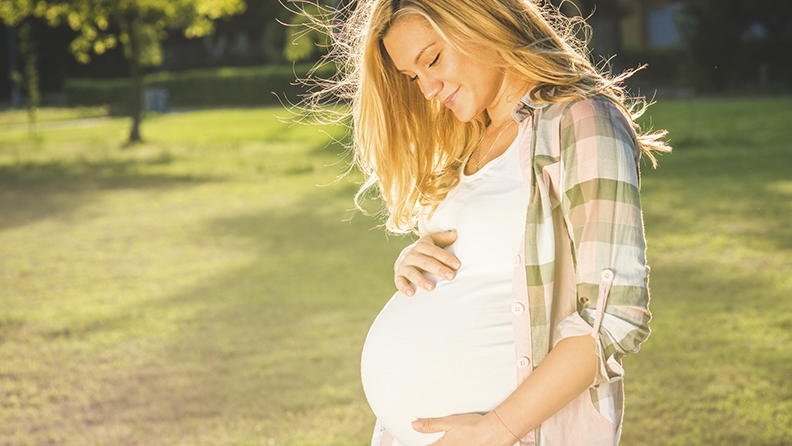Acupuncture is widely recognised to help induce labour, ripening the cervix at full term and shortening the time between expected due date and actual time of delivery. Specific acupoints can also help to reposition the baby, in the case of posterior, transverse or breech position. Induction treatment encourages efficient contraction of the uterine muscle, provides pain relief and facilitates smoother delivery.
If you’ve been seeing an acupuncturist during your pregnancy, he or she will begin to use these points at the right time for you. If you make it to full or past term and have never tried acupuncture before, it is worth booking to see a registered practitioner for treatment targeted to bring on labour.
Some women choose to incorporate acupuncture for pain relief during labour itself, though this is not always a viable option. The good news is that there are a few simple acupressure points that are safe and may be just as effective as needling.
This is a wonderful way for your partner or support person to provide active care for you during childbirth, and can make contractions more efficient as well as less painful. Some of these points have strong stimulatory effects on the uterine muscle so should not be used before 39 weeks to avoid risk of miscarriage.
It should also be noted that acupressure can be used in conjunction with medical pain relief. If you try acupressure and it helps, wonderful. If you try acupressure in combination with other interventions this is also a positive. It will be clear to the labouring woman and her midwife and doctor if the acupressure is providing effective pain relief. The reality is that western medical drug and surgical interventions will be involved in a certain number of births. What’s important is you choose what is right for you.
Three acupressure points to try
Here are just three of the most commonly used points. As a general rule, apply direct and firm pressure on the described area rather than massaging or rubbing. For pain relief during labour, begin acupressure as early as possible and be guided by what feels right as to which points are effective.
Acupressure treatment should not be uncomfortable in itself. A heavy or dull sensation is normal at the acupoint when pressure is applied correctly.
NOTE: It is safe to practice locating these points during pregnancy, but take care not to apply regular or intense pressure before 39 weeks.
SP6 – San Yin Jiao
The ‘crossing point’ of the three yin meridians in the leg, SP6 works to soften the cervix, allowing it to dilate, and is therefore useful in early stage labour. Locate this point by measuring four of the woman’s finger-breadths above the tip of the ankle bone, on the inner aspect of the shin. The area will often feel tender to touch. The woman or support person should apply firm pressure with the thumb or index finger for about one minute on one leg, and follow with the other side about 20 minutes later. Once contractions are efficient and regular, acupressure at this point can be discontinued.
LI4 – He Gu
This point is located in the fleshy region between thumb and first finger on the back of the hand. It should feel tender when applying pressure with the thumb of your opposing hand (or even better, when pressed firmly by someone else). You should feel a dull aching sensation when stimulating this point correctly, often described as feeling like a ‘headache in the hand.’ It is a good option to use for general pain relief during labour, and can stimulate effective uterine contractions. This point helps the body push the baby down through the birth canal, so can be especially useful when the woman is tired during labour.
GB21 – Jian Jing
Effective for encouraging uterine contraction, and useful post-labour for stimulating milk supply, this is a great one to use both during labour and postpartum. Locate this point by finding the midpoint between the bony prominence at the base of the neck and the top of the shoulder joint, at the highest point of the shoulder muscle on both sides. Apply firm pressure with thumb or elbow at the beginning of each contraction, and be sure to use arm strength rather than thumb strength to avoid tired thumbs.
A registered acupuncturist will be able to provide advice, more points to use and comprehensive instructions for each.







